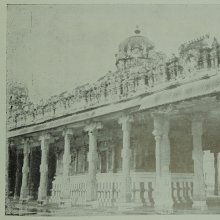Mayana, Mayanā: 9 definitions
Introduction:
Mayana means something in Hinduism, Sanskrit, the history of ancient India, Marathi, Jainism, Prakrit. If you want to know the exact meaning, history, etymology or English translation of this term then check out the descriptions on this page. Add your comment or reference to a book if you want to contribute to this summary article.
Images (photo gallery)
India history and geography
Source: Singhi Jain Series: Ratnaprabha-suri’s Kuvalayamala-katha (history)Mayaṇa (मयण) refers to one of the various shops or “market places” (Sanskrit: Haṭṭa, Prakrit: Cauhaṭṭa) for a medieval town in ancient India, which were vividly depicted in Kathās (narrative poems), for example, by Uddyotanasūri in his 8th-century Kuvalayamālā.—The Kuvalayamala (779 A.D.) is full of cultural material which gains in value because of the firm date of its composition. [...] In the Kuvalayamālā, some names of shops according to articles displayed in them is given, [i.e., mayaṇa] [...] Thus Uddyotana has in his view a complete form of a medieval market place with the number of lines full of different commodities.

The history of India traces the identification of countries, villages, towns and other regions of India, as well as mythology, zoology, royal dynasties, rulers, tribes, local festivities and traditions and regional languages. Ancient India enjoyed religious freedom and encourages the path of Dharma, a concept common to Buddhism, Hinduism, and Jainism.
Languages of India and abroad
Marathi-English dictionary
Source: DDSA: The Molesworth Marathi and English Dictionarymayanā (मयना).—m (Or mainā from H) A kind of jay, Gracula religiosa. 2 Commonly mānā.
--- OR ---
māyanā (मायना).—m ( A) Meaning, signification, import. See further under the commoner form mānā.
Source: DDSA: The Aryabhusan school dictionary, Marathi-Englishmāyanā (मायना).—m Meaning. See mānā.
Marathi is an Indo-European language having over 70 million native speakers people in (predominantly) Maharashtra India. Marathi, like many other Indo-Aryan languages, evolved from early forms of Prakrit, which itself is a subset of Sanskrit, one of the most ancient languages of the world.
Sanskrit dictionary
Source: Cologne Digital Sanskrit Dictionaries: Aufrecht Catalogus CatalogorumMāyaṇa (मायण) as mentioned in Aufrecht’s Catalogus Catalogorum:—father of Sāyaṇa.
Source: Cologne Digital Sanskrit Dictionaries: Monier-Williams Sanskrit-English DictionaryMāyaṇa (मायण):—m. Name of the father of Mādhava and Sāyaṇa, [Catalogue(s)]
[Sanskrit to German]
Sanskrit, also spelled संस्कृतम् (saṃskṛtam), is an ancient language of India commonly seen as the grandmother of the Indo-European language family (even English!). Closely allied with Prakrit and Pali, Sanskrit is more exhaustive in both grammar and terms and has the most extensive collection of literature in the world, greatly surpassing its sister-languages Greek and Latin.
Prakrit-English dictionary
Source: DDSA: Paia-sadda-mahannavo; a comprehensive Prakrit Hindi dictionary1) Mayaṇa (मयण) in the Prakrit language is related to the Sanskrit word: Madana.
2) Mayaṇā (मयणा) also relates to the Sanskrit word: Madanā.
3) Mayaṇā (मयणा) also relates to the Sanskrit word: Madanā.
Prakrit is an ancient language closely associated with both Pali and Sanskrit. Jain literature is often composed in this language or sub-dialects, such as the Agamas and their commentaries which are written in Ardhamagadhi and Maharashtri Prakrit. The earliest extant texts can be dated to as early as the 4th century BCE although core portions might be older.
Kannada-English dictionary
Source: Alar: Kannada-English corpusMayaṇa (ಮಯಣ):—
1) [noun] a plastic, dull-yellow substance secreted by bees for building cells; bees-wax.
2) [noun] a kind of adhesive paste prepared using the flour of some corns.
3) [noun] any of various solid or semisolid, viscous, yellowish or brownish organic substances exuded from various plants and trees, that is used as or in preparing adhesives; gum.
4) [noun] Manmatha, the Love-God.
5) [noun] compelling or strong love; passion.
6) [noun] the dark brown bird Acridotheres tristis of Sturnidae family, with yellow beak, black head, short, white bordered black tail, yellow legs; common myna.
7) [noun] ಮಯಣದ ಬಟ್ಟೆ [mayanada batte] mayaṇada baṭṭe a protective covering of canvas or other material waterproofed with wax; tarpaulin; ಮಯಣದ ಬತ್ತಿ [mayanada batti] mayaṇada batti a long, usu. slender piece of wax with an embedded wick that is burned to give light; a candle.
Kannada is a Dravidian language (as opposed to the Indo-European language family) mainly spoken in the southwestern region of India.
See also (Relevant definitions)
Starts with: Mayana-kuruvitosham, Mayanajujjha, Mayanakkarai, Mayanakkiriyai, Mayanakkollai, Mayanalinkam, Mayanam, Mayanamkusa, Mayanananam, Mayanasala, Mayanasalaga, Mayanasalaya, Mayanasundari, Mayanavacini, Mayanavairakkiyam, Mayanavairavan, Mayanaya.
Ends with (+80): Abhinavacampuramayana, Adbhutaramayana, Adhyatmaramayana, Agnishamayana, Agnisharmayana, Amararamayana, Anandaramayana, Angirasamayana, Arsharamayana, Arsheyaramayana, Aryaramayana, Ashcaryaramayana, Ashmayana, Astamayana, Balaramayana, Bhaimayana, Bhasmayana, Bhavishyaramayana, Brahmayana, Campuramayana.
Full-text (+12): Madana, Krishnapinditaka, Mayanakkarai, Astamaya, Krishnapindira, Piretavanam, Uruttirapumi, Kanjaka, Mayana-kuruvitosham, Sammayana, Cutukatu, Kanjana, Kaitarya, Kaitaryya, Patunilam, Pollanilam, Madanashalaka, Palakan, Pulaiyan, Garmut.
Relevant text
Search found 5 books and stories containing Mayana, Mayanā, Māyanā, Māyaṇa, Mayaṇa, Mayaṇā; (plurals include: Mayanas, Mayanās, Māyanās, Māyaṇas, Mayaṇas, Mayaṇās). You can also click to the full overview containing English textual excerpts. Below are direct links for the most relevant articles:
The Religion and Philosophy of Tevaram (Thevaram) (by M. A. Dorai Rangaswamy)
Chapter 44 - Thirukadaiyur Mayanam or Tirukkatavur (Hymn 53) < [Volume 3.4 - Pilgrim’s progress: with Paravai]
Introduction < [Volume 3.4 - Pilgrim’s progress: with Paravai]
Chapter 4.3 - (e) Arurar’s references to Dance < [Volume 2 - Nampi Arurar and Mythology]
The Sarva-Darsana-Samgraha (by E. B. Cowell)
Early Chola Temples (by S. R. Balasubrahmanyam)
Temples in Tirukkuruhavur < [Chapter VIII - Temples of Uttama Chola’s Time]
Part I, Stone < [Chapter XI - Sculpture]
The Devi Bhagavata Purana (by Swami Vijñanananda)
Hoysala Bequest To Indian Art < [January-February, 1930]
